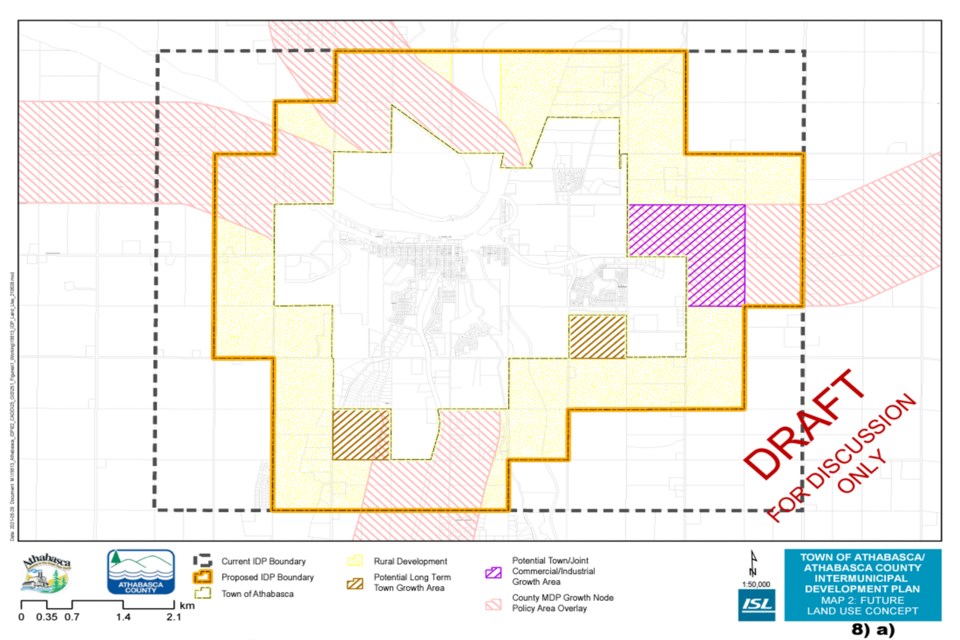ATHABASCA – At long last, the document that will guide the future development of areas within the borderlands of the Town of Athabasca and Athabasca County is complete.
A joint public hearing before town council’s Oct. 5 regular meeting that also included members of Athabasca County council via Zoom wrapped up quickly with no one speaking for or against the intermunicipal development plan (IDP), which both municipalities have been working on with consultants for well over a year-and-a-half.
Municipalities were mandated, through changes to the Municipal Government Act under the former NDP government, to work with all their neighbours to create IDPs. The UCP government changed the requirement when it took power in 2019. While the town only had one document to prepare, the county was required to create plans for any future development with its surrounding rural municipalities, as well as the numerous summer villages that populate the shores of area lakes.
After hearing from ISL Engineering land-use planning manager Dave McRae and project planner Derek Macdonald, town council voted to approve the plan following the public hearing. County councillors did the same at their Oct. 12 meeting, making the document official.
“It applies to radius around the Town of Athabasca ranging between one half and one-and-a-half miles. It identifies long-term town growth areas, but it also recognizes development opportunities for the county in the IDP area,” McRae said, as he started his presentation. “It also provides potential opportunities for joint commercial or industrial development and is basically an opportunity in lieu of annexation of some areas, and the IDP contains policies regarding land use, transportation, servicing, annexation, intermunicipal collaboration and then administrative provisions relating to referrals, communications, and dispute resolution between the two municipalities.”
The last IDP between the town and county was approved in 2011, but the new document also identifies potential long-term town growth areas, such as south of Cornwall, which have been identified for future town residential and industrial growth based on available servicing; a potential town or joint commercial industrial growth area on the east end of town; a growth node policy that applies to highway corridors and future commercial or light industrial development; and a rural development policy that identifies areas for agricultural and future county residential development.
“The plan also provides defined area structure plan (ASP) requirements for subdivisions that are proposed of five parcels or 20 acres in total or greater,” said McRae. “An ASP is required prior to rezoning for country residential development in accordance with the county's MDP (municipal development plan); Alberta Transportation may require an area structure plan for subdivision in proximity to the highways in the plan area … The plan also promotes the development of compatible land uses and provides for buffering where needed.”
Part of the plan was to determine three future growth scenarios and how much residential, commercial and residential land would be required for each over the next 50 years.
“The Town of Athabasca has an oversupply of residential and industrial land, and undersupply of commercial land,” reads section 1.4 of the IDP document. “Regardless of the assumed population growth scenario, it will take more than 50 years to exhaust the current supply of residential and industrial land, while there is not enough unabsorbed commercial land to meet the requirements for the next 10 years.”
While feedback from the public wasn’t extensive, the county did receive correspondence from the Alberta Lands Division office that noted it had no concerns with the plan, and from TC Energy which was looking for additional policy language regarding development and proximity to pipelines, but the county determined that language could be found in other documents.
As far as the engagement process over the course of the development of the IDP, Macdonald pointed out that while there was no opportunity for in-person engagement there were several opportunities for residents, landowners and stakeholders to participate and let any concerns they may have had to be aired.
A virtual community session was held in February and saw 17 in attendance, while an online survey resulted in only three submissions. There was also a single one-on-one landowner meeting and another call that took place in Phase 1 of the community engagement process. In August, during Phase 3, a similar virtual meeting took place that drew two attendees from the public and another survey that resulted in five responses, Mcdonald said.
Athabasca County reeve Larry Armfelt commented it had indeed been a lengthy process, but commended members of both municipalities for their collaborative approach and willingness to make sure both parties were satisfied with the outcome.
“So, in my belief, now, this is just me, this is a work in progress, as we know, things change, but I believe it's an excellent document for a basis of operation for both the municipalities. It's not written in stone, it is a work in progress, but it was done in good faith by everybody. And it's been a pleasure, thank you kindly,” he said.
Mayor Colleen Powell agreed full-heartedly.
“It leaves a lot of openings for further collaboration between the town and the county to iron out some of the issues that we know are there but haven't had time or money or whatever to deal with over the next few years and I hope this stays as a living document,” she said.
Powell also noted the town would be tackling its own municipal development plan and land-use bylaw in the coming term, and the new IDP will play a big role in the new versions of those documents as well.



